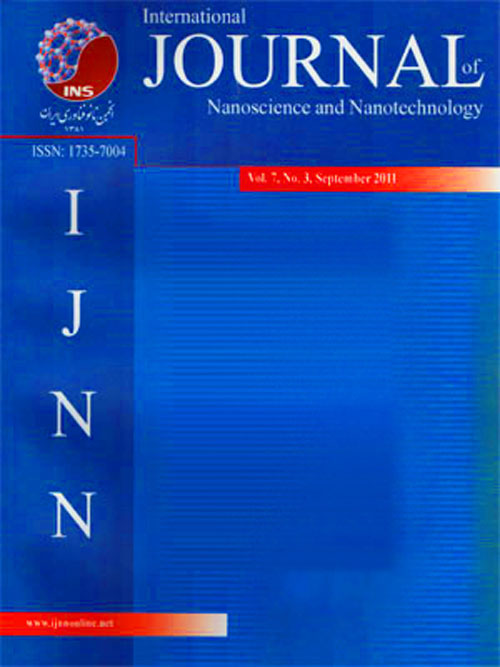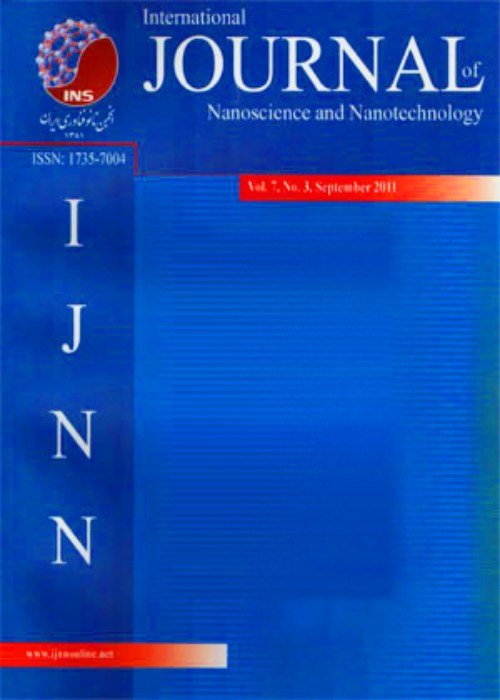فهرست مطالب

International Journal Of Nanoscience and Nanotechnology
Volume:12 Issue: 2, Spring 2016
- تاریخ انتشار: 1395/04/08
- تعداد عناوین: 6
-
-
Pages 71-77In this paper, we present the results of single-electron tunneling in two-dimensional (2D) hexagonal closed packed arrays of palladium nanoparticles. After inspecting the emergence of Coulomb blockade phenomena, we demonstrate the possibilities of using these arrays as a single-electron tunneling based hydrogen sensor. We assumed arrays of palladium nanoparticles with diameters of 3.5 and 6 nm based on the arrays synthesized experimentally. Using SIMON simulator, we obtained IV characteristics of equivalent circuits, consisting palladium nano-islands and tunneling junctions between source-drain electrodes, before and after exposing to hydrogen gas at room temperature. Resistance and capacitance of tunneling junctions were calculated according to the lattice parameter expansion of palladium nanoparticles at different pressures of hydrogen gas. We observed the change in the total resistance of the device before and after exposure to hydrogen. The obtained results indicate that this configuration show single-electron tunneling and can be used as the hydrogen gas sensor. This sensor can detect concentrations as low as 1.3% in air which is less than ammability concentration.Keywords: Monodisperse palladium nanoparticles, Hydrogen gas sensor, Single electron tunneling, Room temperature
-
Pages 79-90Single crystals consisting various surface morphologies and epitaxial structures were applied to investigate the effect of other phase regions in the vicinity of a given tethered chains-covered area having a certain molecular weight of amorphous brushes. The designed experiments demonstrated that regardless of the type of surface morphology (patterned and especial mixed-brushes, homo and copolymer single-co-crystals or homo-brush single crystals and epitaxial structures), for a phase region covered by a certain type of brushes, the respective characteristics were similar. Detection of participating phases was possible by atomic force microscopy (AFM) on the basis of quality of employed solvent (amyl acetate) in growth systems, interaction of brushes with respective substrate, stiffness, and crystallinity of PEG-formed areas; hence, fabricated surfaces were not in need of any selective solvent to be detected. Moreover, structure of various single crystals was investigated by the help of conjunction thickness.Keywords: Epitaxial, Mixed, brush, PEG, Single, co, crystal, Single crystal
-
Pages 91-101A facile method for synthesis of amino functionalized silica coated Fe3O4 magnetic nanoparticles is introduced. For this purpose, the surface of magnetic nanoparticles (MNPs) was modified with two precursors of silica which produced amine and vinyl functional groups on the surface of magnetic nanoparticles. The modified magnetic nanoparticles were characterized by transmission electron microscopy (TEM), X-ray powder diffraction (XRD), vibrating sample magnetometry (VSM) and thermo-gravimetric analysis (TGA). Results showed that, in the presence of vinyl precursor, the stability of silica matrix clearly improved. Moreover, the amino functionalized magnetic nanoparticles were used as a sorbent for solid-phase extraction of trace lead and cadmium in different food samples such as rice, wheat, milk and shrimp. The effects of various parameters such as pH, extraction time and adsorbent content were investigated in order to establish the optimum conditions for the extraction and determination of lead and cadmium. The regeneration studies also showed that modified magnetic nanoparticles can be used several times for the adsorption of lead and cadmium without loss of their magnetization properties.Keywords: Solid phase extraction, Lead, Cadmium, Amino, vinyl functionalized magnetic nanoparticles
-
Pages 103-108Biodegradable elastomeric materials are gaining extensive attention in the field of soft tissue engineering. Poly (glycerol sebacate) (PGS) is a novel biocompatible elastomer in this scope. However this polymer has poor mechanical properties especially when the molar ratio of glycerol is higher than sebacic acid. Calcium Titanate (CaTiO3) is a biocompatible ceramic with some degrees of piezoelectricity, which is in favor of cell growth. In this study; Calcium Titanate is synthesized at nano-scale by sol-gel method and dispersed into as-synthesized PGS pre-polymer in weight-ratio of 5:95 for CaTiO3 and PGS, respectively. This waxy material was cured to achieve the final product. The molar ratio of glycerol and sebacic acid for the synthesis of PGS was 1:0.8, respectively. X-ray diffraction (XRD) test confirms successful synthesis of CaTiO3 and the nano-scale of crystals are approved by transmission electron microscopy (TEM) Image. Fourier transform infrared (FTIR) spectroscopy has revealed a chemical bond between the two phases after addition of ceramic into pre-polymer. Distribution of CaTiO3 nano-structures in the polymeric matrix is shown by Scanning Electron Microscopy (SEM).Keywords: Elastomer, Poly(glycerol sebacate), Calcium Titanate, Nano, composite
-
Pages 109-118Development of components that can form large molecular aggregates through noncovalent interactions, in nano size structures, has been an active area of research. In current study, a nano-sized Pb(II) coordination polymer, {[Pb(pydc)(pydc.H2)(H2O)2]2}n (1), where [pydc.H2= 2,6-pyridinedicarboxylic acid), were synthesized by sonochemical method and characterized by field emission scanning electron microscope (FESEM), X-ray powder diffraction (XRD), FT-IR spectroscopy and elemental analyses. The sizes of the nano-structures were approximately 90 nm. The thermal stability of compound 1 has been studied by thermal gravimetric (TG) and differential thermal analyses (DTA). The crystal structure of compound 1, based on an X-ray structural analysis has been reported before, in which the crystal dimensions was in millimeter range. Pure phase PbO nanoparticles were simply obtained by calcination of nano-sized compound 1 at 600 °C under argon atmosphere and the particles size of the PbO were about 26 nm. This study demonstrates that the coordination polymers may be suitable precursors for the simple one-pot preparation of nanoscale metal oxide materials with different and interesting morphologies.Keywords: Lead (II) oxide nanoparticles, Nano, sized coordination polymer, Sonochemical method
-
Pages 119-130ZnO nanorods (NRs) were synthesized using an in situ low-temperature hydrothermal method. In order to investigate the effect of different seed layers on quality of ZnO NRs arrays, alcoholic, alkaline and acidic seed solutions were deposited by spin coating on ITO-glass substrate. Experimental results revealed that the vertically ZnO NRs obtained from monoethanolamine-based seed layer is the most uniform and compact one. Alkali solutions result in better alignment and uniform cross sections than those realized via acetic acid-based seed layer. Also, KOH- based seed layer show lower density and bigger cross section of ZnO NRs than that of NaOH based seed layer. Evolution of ZnO NRs layer was investigated by SEM images and UV-visible spectra at different growth times. By increasing growth time, the wavelength of UV-vis absorption edge exhibit a red-shift and the transmission of the light in visible and infrared regions decrease and therefore, the energy band gap of ZnO NRs decrease. Also, Oxygen plasma treatment resulted in increasing of UV absorption of ZnO NRs thin film. Scanning electron microscopy and X-ray diffraction spectra indicated that the crystalline ZnO NRs have rod shapes with hexagonal cross sections.Keywords: Hydrothermal synthesis, Thin film, UV photodetection, ZnO NRs


